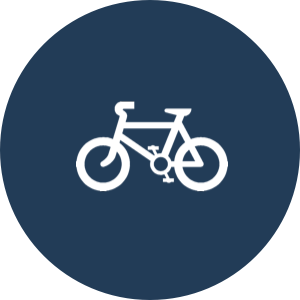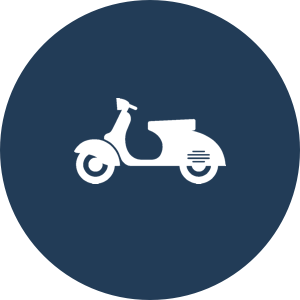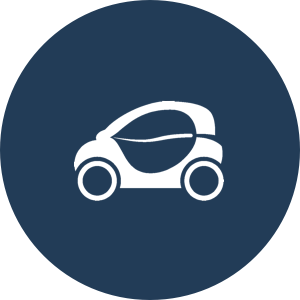World-Class Transit
REINVENTING MUNI
Imagine a San Francisco where a cross-town journey takes under 15 minutes on a driverless train instead of over an hour by bus. A world-class network of truly rapid transit lines connecting you throughout the city, not just downtown. More capacity to finally handle today's demand, with room to grow to handle tomorrow's. Consistent spacing and reliability so you can know you won't be left stranded. That's transportation fit for San Francisco.
“A developed country is not a place where the poor have cars, it's where the rich use public transportation”
— Enrique Peñalosa
Politicians have been talking for decades about "fixing Muni," yet Muni remains one of the slowest systems in the nation with poor reliability, overcrowded vehicles, and infrequent service. Incremental changes alone can't build the system we desperately need.
It's time for a real vision to connect the city—and our region—with high-speed, high-frequency, reliable transit service for everyone.
We have a real opportunity to create the greatest modern urban transportation network in the world.
New Muni Metro
A Whole New Muni
As driverless cars and private commuter solutions grow, we need to step back and look at where public transit truly shines. High-speed, high-capacity, high-frequency, automated metro trains can equitably serve our entire population faster, cheaper, and more reliably than any other service.
We can come together and build this future—strengthening the power of our communities and our city.
Learn more about New Muni Metro

We start by reclaiming the Muni Metro as the M-Market: a true automated, frequent, high-speed urban subway. Above-ground trains become part of the Muni Tramway network, ensuring transfer points to high-speed Metro service. This model eliminates underground delays, ensures consistent train frequency, and allows for platform-length high-capacity trains below ground.
Above-ground, we gain more frequent service, low-platform trams for easier and faster boarding, and a system where one delay won't impact other lines. This sets the stage for expansion of the current network: J-Church expansion up Fillmore, N-Judah through SoMa and Mission Bay, K-Ingleside up 19th Avenue, the T-Third to the Marina, and the L-Taraval to Bayshore.
Going beyond, we begin to expand our metro network with true metro service on the D-Van Ness/Mission, B-Geary, and H-Potrero/Divisadero routes.
Learn more about New Muni Metro
Transfer Hubs
Integrated Connections
As our system grows, efficient transfer points become increasingly important. In conjunction with the Duboce Market Halls neighborhood plan, transit connections breathe life into our streets while providing seamless, rapid transfer opportunities to travel to every corner of San Francisco—and beyond.
As part of the New Muni Metro vision, we've identified a number of new transfer hubs that will serve to connect the city.

Duboce Market
Church and Market

Randall
Mission and Randall

The Hub
Van Ness and Market

Balboa Park
Balboa Park

Japantown
Geary and Fillmore

Bayshore
Visitacion Valley

West Portal
West Portal and Ulloa

Transbay Terminal
Downtown
Regional Transportation
Connecting the Bay Area
A strong bay area transit coalition is critical to connecting our region, maintaining our affordability, increasing economic vitality for the entire region, and reducing congestion both within the city and in our surrounding communities.
A truly grand vision for transit in the bay area includes an urban network, an inner regional network, an extended regional network, as well as long-distance trains. We need to connect SMART and regional trains to our north into San Francisco to properly link us to our northern neighbors. It's imperative that we build a new transbay tube crossing to the East Bay—both to double BART capacity into and out of the city, and to allow greater regional train connections.
Given the time it will take to expand our regional train network, it's time to fully re-evaluate transportation on the Bay Bridge, whether it be lightweight trains or even very long (train-like) buses.

We also have an incredible opportunity to work with a number of companies located to our south to form a public transportation plan to provide quick access down the peninsula without running "Corporate Tech Shuttles" throughout our city streets. Let's support the creation of public transportation options, providing efficient regional connection hubs with a solid urban transit network.
photograph: Patrick Lydon | sociecity
Multimodal Shared Mobility
Connecting Every Part of the Network
While high-speed transit lines throughout our city and region will revolutionize mobility in San Francisco, it doesn't paint a complete picture of mobility. From last-mile connections to picking up goods to better exercise, a complete transportation network includes a full range of options from scooters to bicycles to cars.
Shared services help reduce congestion and parking constraints for those who drive, while providing options for San Franciscans at a variety of price points. We need to commit to and expand these services.
 Bikeshare
Bikeshare
Everyone in San Francisco should be less than a 5-minute walk from a shared bike. We also need fully dedicated bike lanes to ensure safety and availability of biking for every San Franciscan.
 Electric Bikes & Scooter Share
Electric Bikes & Scooter Share
Not every route makes sense on a bike, but electric-assist bicycles and scooters can help fill that gap. Every metro stop should have access to shared electric-assist bikes and scooters.
 One-Way Car Share
One-Way Car Share
In every commercial district, every major transit stop, and dispersed throughout neighborhoods should be one-way urban-optimized shared electric cars.
Muni Connect
Introducing Muni, On-Demand
Introducing the first public transit on-demand service, accessible by phone, computer, app, or by simply swiping you clipper card at a stop. Muni comes to you, connecting you directly to the New Muni Metro network.
We start by serving underserved neighborhoods, looking at where low-frequency connector bus lines run today. For each of these zones, we designate 1-3 main artery connections and provide on-demand service from anywhere within that zone to any of these arterial connections. This service, much like other real-time routing systems, may pick up one or more people. In reverse, arriving at a designated arterial connection point can offer a ride anywhere within the specified zone.




